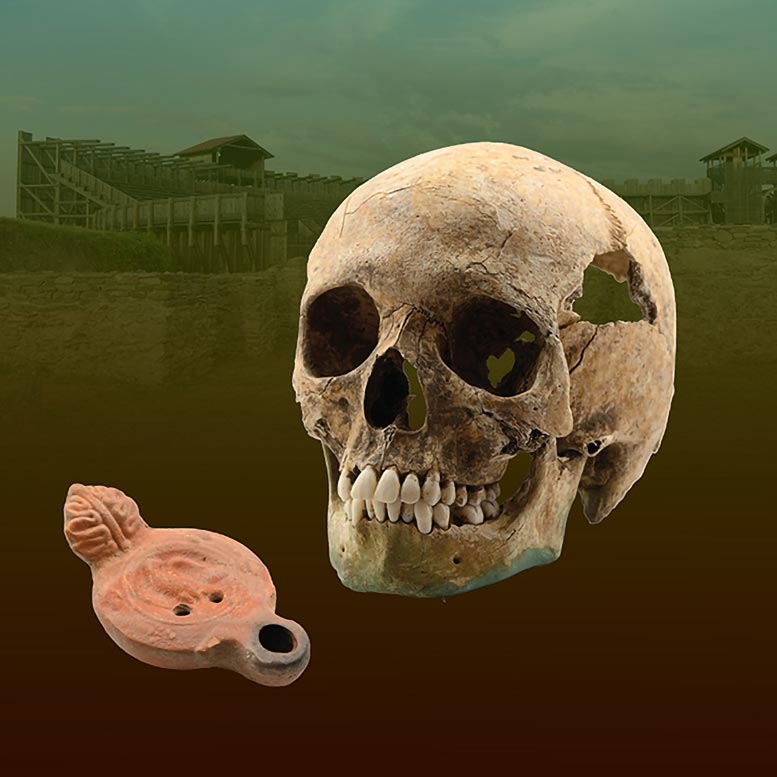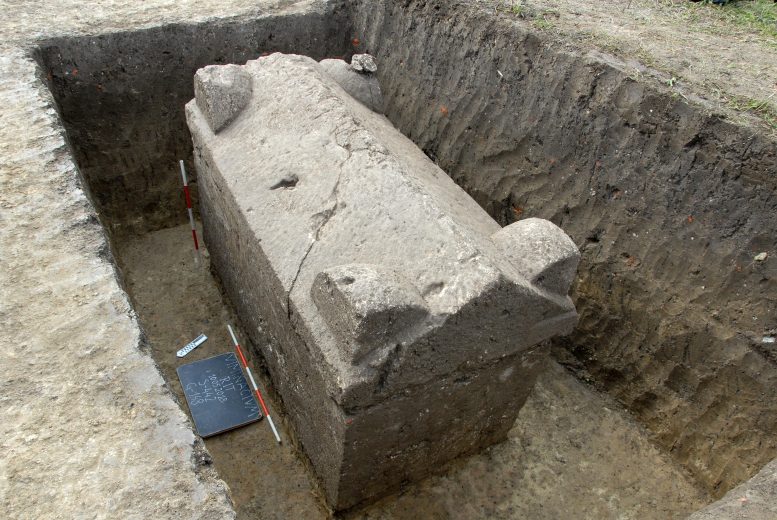
Skull of an individual of ancestral East African origin found at Viminacium, with the oil lamp representing an eagle found in his tomb. Credit: Miodrag (Mike) Grbic
A study exploring the genomic history of the Balkans reveals profound Anatolian and Slavic demographic influences during the first millennium, reshaping our understanding of the region’s past through a mix of archaeogenetic and historical data.
A multidisciplinary study has reconstructed the genomic history of the Balkan Peninsula during the first millennium of the Common Era, a time and place of profound demographic, cultural and linguistic changes. The team retrieved and analyzed comprehensive genomic data from 146 ancient peoples discovered primarily in Serbia and Croatia, more than a third of which came from the Roman military frontier at the huge Viminacium archaeological site in Serbia, which they co-analyzed with data from the rest of the Balkans and neighboring regions.
Cosmopolitanism and migrations in the Roman era
The work, published in the journal Cell, highlights the cosmopolitanism of the Roman frontier and the long-term consequences of the migrations that accompanied the breakdown of Roman control, including the arrival of people speaking Slavic languages. Archaeological DNA reveals that despite the borders between nation-states that divide them, the populations of the Balkans have been shaped by shared demographic processes.
“Archaeogenetics is an essential complement to archaeological and historical evidence. A new and much richer picture emerges when we synthesize written records, archaeological remains such as funerary objects and human skeletons, and ancient genomes,” said co-author Kyle Harper, a historian of the ancient Roman world at the University of Oklahoma.

An exceptionally rich sarcophagus discovered at Viminacium in which a man of local origin and a woman of Anatolian origin were buried. It features several gold and silver objects including two gold earrings, a silver mirror, a silver brooch and 151 gold beads. Credit: Ilija Mikic
Demographic changes and Eastern influences
After Rome occupied the Balkans, it transformed this border region into a crossroads that would eventually give rise to 26 Roman emperors, including Constantine the Great, who moved the empire’s capital to the Eastern Balkans when he founded the city of Constantinople.
The team’s analysis of ancient DNA shows that during the period of Roman control, a significant demographic contribution of people of Anatolian origin left a long-term genetic imprint in the Balkans. This shift in ancestry is very similar to what a previous study showed in the megacity of Rome itself – the original core of the empire – but it is remarkable that it also happened on the periphery of the Roman Empire.
What is particularly surprising is that there is no evidence of a genetic impact in the Balkans of migrants of Italic origin: “During the imperial period, we detect an influx of Anatolian ancestry into the Balkans and not that of populations descended from the people of Italy,” said Íñigo Olalde, an Ikerbasque researcher at the University of the Basque Country and co-lead author of the study. “These Anatolians were intensely integrated into local society. Viminacium, for example, there is an exceptionally rich sarcophagus in which we find a man of local origin and a woman of Anatolian origin buried together.
The team also discovered cases of sporadic long-distance mobility from distant regions, such as that of a teenager whose ancestral genetic signature most closely matches the Sudan region of sub-Saharan Africa and whose diet during his childhood was very different from that of the rest of the population. individuals analyzed. He died in the 2nd century CE and was buried with an oil lamp depicting eagle iconography related to Jupiterone of the most important gods to the Romans.
“It is not known whether he was a soldier, slave or merchant, but genetic analysis of his burial reveals that he probably spent his early years in the region of present-day Sudan, outside the limits of the Empire, then followed a long journey that ended with his death in Viminacium (now Serbia), on the northern border of the Empire,” said Carles Lalueza-Fox, senior researcher at the Institute of Biology evolutionary and director of the Museum of Natural Sciences of Barcelona.
Incorporation of “barbarian” peoples and Nordic influences
The study identified individuals of mixed North European and Pontic origin in the Balkans from the 3rd century onwards, well before the final collapse of Roman imperial control. Anthropological analysis of their skulls shows that some of them were artificially deformed, a custom typical of certain steppe populations, including groups described by ancient authors as “Huns”. These results reflect the integration of peoples from across the Danube into Balkan society centuries before the fall of the Empire.
“The boundaries of the Roman Empire differed from those of today’s nation states. The Danube served as a geographical and military border for the Empire. But it also acted as a crucial communications corridor, permeable to the movement of people attracted by the riches that Rome invested in its border area,” said co-author Michael McCormick, the Francis Goelet Professor of Medieval History at the Harvard University.
Slavic influence and demographic changes
The Roman Empire permanently lost control of the Balkans in the 6th century, and the study reveals the subsequent large-scale arrival in the Balkans of individuals genetically similar to modern Slavic-speaking populations from Eastern Europe. Their genetic footprint represents 30-60% of the ancestry of today’s Balkan peoples, representing one of the largest permanent demographic changes in Europe during the early medieval period.
The study is the first to detect the sporadic arrival of individual migrants that long preceded later population movements, such as a woman of Eastern European origin buried in a high imperial cemetery. Then, from the 6th century, migrants from Eastern Europe were observed in greater numbers; as in Anglo-Saxon England, demographic changes in this region are at the extreme high end of what happened in Europe and are accompanied by linguistic changes.
“According to our ancient DNA analyses, this arrival of Slavic-speaking populations in the Balkans took place over several generations and involved entire family groups, men and women,” explains Pablo Carrión, researcher at the Institute of Evolutionary Biology and co. -lead author of the study.
The establishment of Slavic populations in the Balkans was more significant in the north, with a genetic contribution of 50 to 60% in present-day Serbia, and progressively less towards the south, with 30 to 40% in mainland Greece and up to 20% in Greece. the islands of the Aegean Sea. “The major genetic impact of Slavic migrations is visible not only in the current Slavic-speaking populations of the Balkans, but also in places that do not speak Slavic languages today, such as Romania and Greece,” said the co-senior author David Reich, professor of genetics at the Blavatnik Institute at Harvard Medical School and professor of human evolutionary biology in the Harvard School of Arts and Sciences.
Interdisciplinary collaboration and modern implications
The study required an interdisciplinary collaboration of more than 70 researchers, including archaeologists who excavated the sites, anthropologists, historians and geneticists.
“This work illustrates how genomic data can be useful in moving beyond contentious debates about identity and ancestry that have been inspired by historical narratives rooted in the nascent nationalisms of the 19th century and that contributed to conflicts in the past,” Lalueza-Fox said.
The team also generated genomic data from various modern-day Serbs that could be compared to ancient genomes and other current groups in the region.
“We discovered that there was no genomic database on modern Serbs. So we sampled people who identified themselves as Serbs based on common cultural traits, even if they lived in different countries like Serbia, Croatia, Montenegro or North Macedonia,” said the co-author Miodrag Grbic, professor at the University of Western Ontario, Canada.
Co-analysis of the data with those of other modern peoples in the region, as well as ancient individuals, shows that the genomes of Croats and Serbs are very similar, reflecting a common heritage with similar proportions of Slavic and local ancestry of the Balkans.
“Ancient DNA analysis can contribute, when analyzed with archaeological data and historical documents, to a richer understanding of Balkan history,” Grbic said. “The image that emerges is not that of division, but of a shared history. Iron Age peoples throughout the Balkans were similarly affected by migration during the time of the Roman Empire and then by Slavic migration later. Together, these influences have resulted in the genetic profile of the modern Balkans, regardless of national boundaries.
To find out more about this research:
Reference: “A genetic history of the Balkans from the Roman frontier to the Slavic migrations” by Iñigo Olalde, Pablo Carrión, Ilija Mikić, Nadin Rohland, Swapan Mallick, Iosif Lazaridis, Matthew Mah, Miomir Korać, Snežana Golubović, Sofija Petković, Nataša Miladinović- Radmilović, Dragana Vulović, Timka Alihodžić, Abigail Ash, Miriam Baeta, Juraj Bartík, Željka Bedić, Maja Bilić, Clive Bonsall, Maja Bunčić, Domagoj Bužanić, Mario Carić, Lea Čataj, Mirna Cvetko, Ivan Drnić, Anita Du gonjić, Ana Đukić, Ksenija Đukić, Zdeněk Farkaš, Pavol Jelínek, Marija Jovanovic, Iva Kaić, Hrvoje Kalafatić, Marijana Krmpotić, Siniša Krznar, Tino Leleković, Marian M. de Pancorbo, Vinka Matijević, Branka Milošević Zakić, Anna J. Osterhol tz, Julianne M. Page Callan, Francesca Candilio, Olivia Cheronet, Daniel Fernandes, Aisling Kearns, Ann Marie Lawson, Kirsten Mandl, Anna Wagner, Fatma Zalzala, Anna Zettl, Željko Tomanović, Dušan Keckarević, Mario Novak, Kyle Harper, Michael McCormick, Ron Pinhasi, Miodrag Grbić, Carles Lalueza -Fox and David Reich, December 7, 2023, Cell.
DOI: 10.1016/j.cell.2023.10.018

